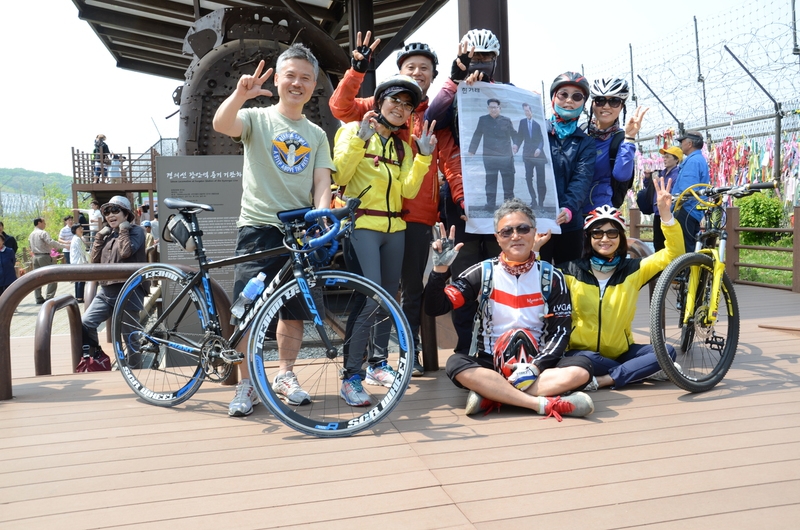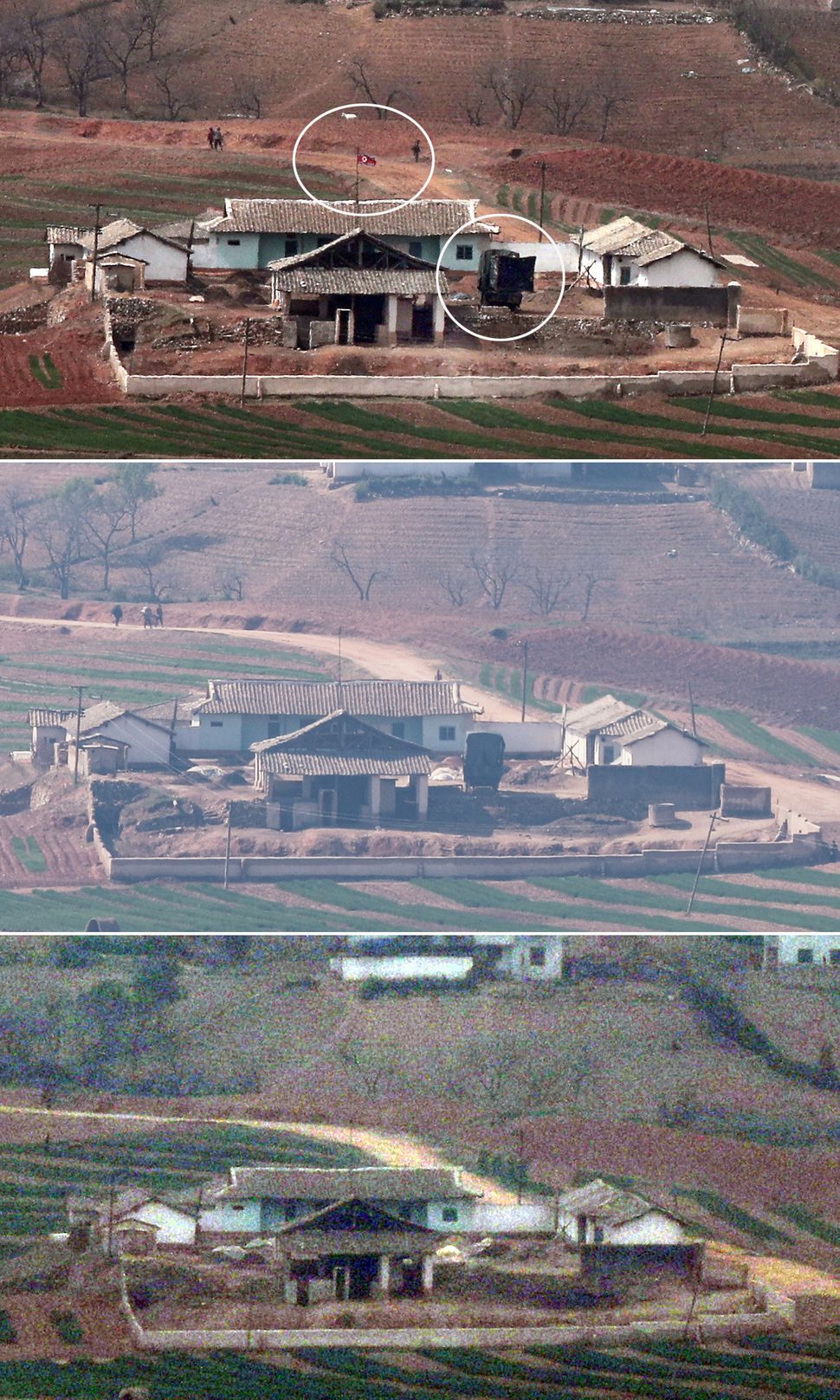Posted on : May.2,2018 17:35 KST
Modified on : May.2,2018 18:10 KST
 |
|
As part of the initial follow-up measure to the Panmunjeom Declaration, South Korean soldiers remove propaganda loudspeakers in a base along the Military Demarcation Line (MDL) in Paju, Gyeonggi Province on May 1. (Photo pool)
|
South Korean government removes more than 40 loudspeakers as initial follow-up measure to Panmunjeom Declaration
For South Koreans living near the border with North Korea in Paju, Gyeonggi Province, division has been part of their daily routine, from the barbed-wire fences running along the Imjin River to the roar of loudspeakers broadcasting propaganda back and forth across the border. For these people, the Panmunjeom Declaration that there would be no more war on the Korean Peninsula was bound to be of particular significance.
On May 1, four days after the inter-Korean summit, the removal of the propaganda loudspeakers marked the first concrete change in the daily lives of these people who thought their surroundings would never change. Children at the elementary school in the village of Daeseong-dong (also known as Freedom Village) in the Gunnae Township of Paju (the only school inside the demilitarized zone, or DMZ) no longer have to grimace when they hear the propaganda broadcasts.
 |
|
North Korean leader Kim Jong-un hands off a bouquet of flowers he received from students of Daesungdong Elementary School (the only school inside the DMZ) to Kim Yo-jong, his younger sister and a central figure in the Workers’ Party of Korea, at Panmunjeom on Apr. 27 moments before the inter-Korean summit. (Joint inter-Korean photo archive)
|
This school, which is attended by the flower girl who handed a bouquet to South Korean President Moon Jae-in and North Korean leader Kim Jong-un before their summit, is just 1km from Panmunjeom and 400m from the military demarcation line.
“About two days before the summit, the constant propaganda broadcasts grew less frequent, and now I hear they’re going to remove the loudspeakers. I think the children and I should be able to relax when we have class outside now,” said a 42-year-old teacher at the school surnamed Lee.
On the afternoon of May 1, the South Korean government removed more than 40 loudspeakers as the first follow-up measure to the Panmunjeom Declaration.
Heo Sim, a 53-year-old resident of Paju’s Unjeong 2 neighborhood, gathered around 30 neighbors to hold an “ansim party” on the evening of Apr. 27. The little party started with a “dad joke” from Heo playing on the double meaning of the Korean word “ansim,” which can either mean “peace of mind” or “beef tenderloin.” Now that residents could live with peace of mind thanks to the summit, he decided the best thing to do was to hold a party and enjoy some tenderloin.
“To get the mood going, I bought 4 kilos of tenderloin and cooked it for everyone. Everyone enjoyed it, though I don’t know if that was the summit or the fact that they got to eat expensive beef,” he laughed.
Heo’s home in Paju is “close enough that we could have a catapult battle with the North if war breaks out,” he said. Mt. Songak in Kaesong, North Korea, is as clearly visible as Seoul’s Mt. Bukhan from Jayu Road, which he uses to go to work. For Heo, peace holds a particularly deep significance.
“Feels like unification might come any day now”
Ko Hyeong-gwon, a 54-year-old resident of Paju’s Munbal neighborhood, went on two “Imjingak bike rides” with eight of his friends around the time of the summit. The first one before the summit was to hope for its success; the second on Apr. 29 was to commemorate a successful event.
“It’s 35km from my house to Imjingak, and it’s just 15km from there to Kaesong,” Ko said.
“Once this declaration opens up the barbed wire fence, I’d like to do a ride from my house to Kaesong,” he added.
 |
|
Cyclists stop underneath a bridge at Imjingak in Paju, Gyeonggi Province, for a commemorative photo celebrating both the inter-Korean summit and the 30th anniversary of The Hankyoreh on Apr. 28, holding a full front-page photo of the summit while signaling the number “3” for “30 years.” (Photo courtesy of local resident)
|
Ko and his friends had to stop their bicycles at Imjingak after the summit, but took a commemorative photograph there holding a copy of the Hankyoreh with a front-page photo of the South and North Korean leaders crossing the Military Demarcation Line together. Such an image would have been imaginable to them last year, when the threat of war was running high.
The summit also held special relevance for 43-year-old Paju resident Choi Su-in, who gave birth to her first child on the day then-President Roh Moo-hyun crossed the border for the 2007 Inter-Korean Summit. At the time, it seemed like the border might open up any day – but the next opening only came after her baby had grown into a fifth-year elementary school student. “Summit baby” Kim Kang-min spoke with a maturity that belied his years.
“My mom told me that the South and North Korean leaders met on the day I was born. After I saw this summit, it feels like unification might come any day now,” he said.
 |
|
A view of a rice farm in Kaepung County, North Hwanghae Province, on the North Korean side of the Military Demarcation Line (MDL) on May 1, the day South Korean soldiers began dismantling loudspeakers used to broadcast anti-North Korea rhetoric. In the latest photo (furthest below) the North Korean flag and the loudspeakers that had been present have been taken down. The top photo shows the same site on Apr. 15, and the middle photo shows the site on Apr. 25. On Apr. 25, the photo shows no flag, and the speakers have been shut. (Yonhap News)
|
By Im Jae-woo, staff reporter
Please direct comments or questions to [english@hani.co.kr]












